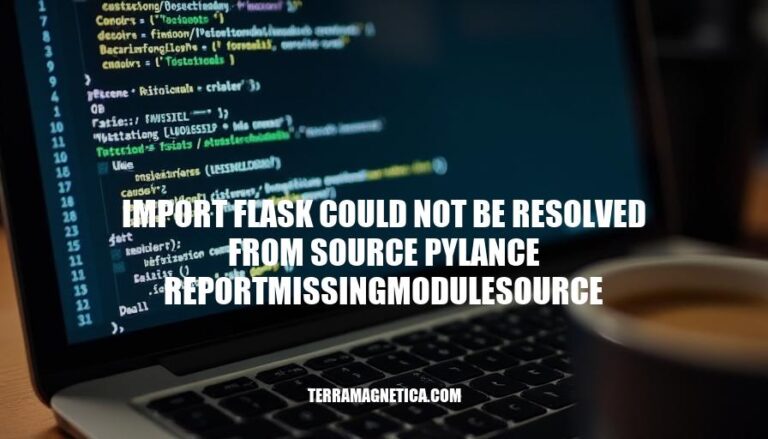


The error “import flask could not be resolved from source Pylance reportMissingModuleSource” is a common issue in Python development, particularly when using Visual Studio Code with the Pylance extension. This error typically occurs when the Flask module is not installed in the current Python environment or when the incorrect Python interpreter is selected in the IDE. To resolve it, ensure Flask is installed and the correct interpreter is configured.
The error message “import flask could not be resolved from source Pylance reportMissingModuleSource” indicates that the Pylance language server in Visual Studio Code (VS Code) cannot find the Flask module in your Python environment. This typically happens for a few reasons:
Flask is not installed: The Flask module might not be installed in your current Python environment. You can install it using pip install flask.
Incorrect Python interpreter: VS Code might be using a different Python interpreter than the one where Flask is installed. You can select the correct interpreter by opening the Command Palette (Ctrl+Shift+P or Cmd+Shift+P on macOS), typing “Python: Select Interpreter,” and choosing the appropriate environment.
Virtual environment issues: If you’re using a virtual environment, ensure it is activated in VS Code. You can activate it by running the appropriate command in the terminal, such as source venv/bin/activate for Unix-based systems or venv\Scripts\activate for Windows.
Pylance configuration: Sometimes, Pylance might not be configured correctly to recognize the module. Ensure that your workspace settings in VS Code are correctly pointing to your Python environment.
By addressing these issues, you can ensure a smoother development experience with Flask in VS Code using Pylance.
Here are the common causes of the ‘import flask could not be resolved from source Pylance reportMissingModuleSource’ error:
Missing Flask Installation:
pip install flask
Incorrect Python Interpreter:
Ctrl+Shift+P (or Cmd+Shift+P on macOS), type “Python: Select Interpreter”, and choose the appropriate one.Virtual Environment Issues:
source venv/bin/activate # On macOS/Linux
.\venv\Scripts\activate # On Windows
Pylance Configuration:
Path Configuration:
Module Name Mismatch:
These steps should help resolve the error and get your Flask application running smoothly!
Here are the steps:
pip show flask
pip install flask.These steps should help resolve the ‘import flask could not be resolved from source pylance reportmissingmodulesource’ error.
Here’s a step-by-step guide to install Flask using pip to fix the ‘import flask could not be resolved from source pylance reportmissingmodulesource’ error:
Open your terminal or command prompt.
Ensure you have Python installed. You can check by running:
python --version
or
python3 --version
Install Flask using pip. Run the following command:
pip install flask
or
pip3 install flask
Verify the installation. You can check if Flask is installed by running:
pip show flask
Restart your code editor. Sometimes, restarting your editor can help it recognize the newly installed packages.
Check your import statement. Ensure you have:
import flask
Run your script again. The error should be resolved.
If you still encounter issues, make sure you are working in the correct virtual environment and that it is activated.
Create a Virtual Environment:
python -m venv venv
Activate the Virtual Environment:
venv\Scripts\activate
source venv/bin/activate
Install Flask:
pip install flask
Configure VSCode:
Ctrl+Shift+P or Cmd+Shift+P on macOS).Python: Select Interpreter and choose the interpreter from your virtual environment.settings.json includes the correct paths:{
"python.pythonPath": "path_to_your_virtualenv/bin/python",
"python.analysis.extraPaths": ["./path_to_your_project"]
}
This setup should resolve the ‘import flask could not be resolved from source Pylance’ error. If you encounter any issues, make sure the virtual environment is activated and the correct interpreter is selected in VSCode.
Install Flask:
pip install flask
Select the Correct Python Interpreter:
Ctrl+Shift+P).Python: Select Interpreter.Configure settings.json:
.vscode/settings.json in your project.{
"python.pythonPath": "path/to/your/python",
"python.analysis.extraPaths": ["./path/to/your/project"]
}
Reload VS Code:
These steps should resolve the ‘import flask could not be resolved from source Pylance reportmissingmodulesource’ error.
Here are the steps:
Ctrl+Shift+P and type Python: Select Interpreter..vscode/settings.json in your project directory.python.analysis.extraPaths:{
"python.analysis.extraPaths": ["./path_to_your_project"]
}
This should help Pylance locate the Flask module.
Verify Flask Installation:
pip show flask.pip install flask.Check Python Interpreter:
Ctrl + Shift + P.Python: Select Interpreter.Configure VSCode Settings:
settings.json.{
"python.pythonPath": "path/to/your/virtualenv/bin/python"
}
Restart VSCode:
import flask.These steps should help resolve the error. If issues persist, double-check your virtual environment and Flask installation.
To resolve the ‘import flask could not be resolved from source Pylance report missing module source’ error, follow these steps:
Ctrl+Shift+P and typing “Python: Select Interpreter”."python.analysis.extraPaths": ["./path_to_your_project"] to include the project path for Pylance analysis.To prevent this error in future projects:
pip show flask or pip install flask if not installed."python.pythonPath": "path/to/your/virtualenv/bin/python".Use a virtual environment for each project to avoid conflicts between dependencies. Ensure your Python interpreter is up-to-date and compatible with the project’s requirements. Regularly update Pylance and other extensions in VS Code to ensure you have the latest features and bug fixes.